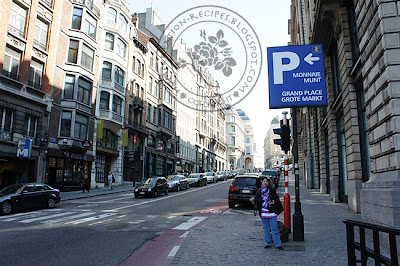We were in Thalys train early morning on the third day from Brussels to Koln (Cologne), Germany. The journey took 1 hour 45mins and we had breakfast which is served in the first class carriage. Once we reached Koln station, we deposited our luggage in automated storage machine (costs €5 for 24 hrs) so that we could look out for something to do before catching up a plane to Hamburg at 4pm.
Looking out from the train station there was a magnificent cathedral - the most well-known architectural monument in Germany mounting to 157metres high. We went around it and saw a double-decker tour bus just besides it and decided to get a ride around the city. The tour took one & half hours and we enjoyed it very much getting to know the place.
By the time we returned back to Koln station, we were terribly hungry as it passed 3pm and at the same time my right leg was terribly throbbing. I was struggling and limping to walk from the bus stop to the train station while going round to look for lunch. We bought fish & chips for lunch but before we could even eat half of it, we realised that we may be out of time to get to the airport. Forgetting about my painful leg, we both running to get the luggages, buying train tickets to the airport & drag the bags up the escalator to the train platform. We both were very panic once we reached the platform because so many trains passing the platform with different destinations and there was no nearby information counter. At the end, we decided to take on the one with a plane symbol flashed in the dashboard. Once we were in the train and after passing several stations, I somehow felt uneasy because I wasn't sure that we were on the right train. I decided to approach some other passengers for help and the girl I spoke to confirmed that we were heading to the wrong airport (Düsseldorf instead of Cologne Bonn). My blood drained down and we knew that we definitely will miss the flight....! We stopped at the next station and get a taxi to drive us to the Koln Bonn airport. The worst news was not just we missed the flight, we gotta buy a new ticket that costed us 4 times more expensive. After negotiation, I manage to get some deduction but still costed me 3 times of the original price that we paid. We had no choice but to proceed and lucky enough to catch a flight scheduled 2 hours later. I was just looking forward and tried not to think so much about the unfortunate event.....
We finally reached Hamburg and my good friend Helge waited for us patiently despite having to wait much longer than anticipated. From Hamburg airport we drove to his village in Molln, about an hour drive. It was such a peaceful village and nice views of historic buildings. We were most welcome by Helge's wife Tina and the night was a good catch up with Helge after he left Miri less than a year ago.
After going round in Molln in the morning, Helge drove us to Hamburg for tour before sending us off to bus station. We had city tour by foot, lunch in one of the prestige shopping store in Hamburg (forgot to ask the name), drove around the city, visited Hamburg botanical garden, Hamburg harbour and finally dinner at Hamburg port at 9pm.
Helge also gave us a treat for dinner and on Helge's recommendation, I tried marinated fish served with sour cream - which is actually uncooked Herrings. It was nice and no fishy smell at all. This dish is popular in Germany and Netherland.
So our trip to Germany ended here and we were on a bus to Amsterdam, departed at 10.30pm. Cannot thank Helge & Tina enough for the marvelous hospitality during our visit and hope we will meet again one day. Watch out for my next update in Amsterdam.










































 Voters were most concerned with public safety and protection, advocating that a better job needs to be done in making sure that persons who are released are less likely to commit crimes. Voters showed strong support for reducing the length of incarceration for nonviolent prisoners who participate in programs that may help to reduce recidivism, such as substance abuse treatment programs. Voters also supported shorter sentences for nonviolent inmates who demonstrate good behavior and are at minimal risk of reoffending.
Voters were most concerned with public safety and protection, advocating that a better job needs to be done in making sure that persons who are released are less likely to commit crimes. Voters showed strong support for reducing the length of incarceration for nonviolent prisoners who participate in programs that may help to reduce recidivism, such as substance abuse treatment programs. Voters also supported shorter sentences for nonviolent inmates who demonstrate good behavior and are at minimal risk of reoffending.








